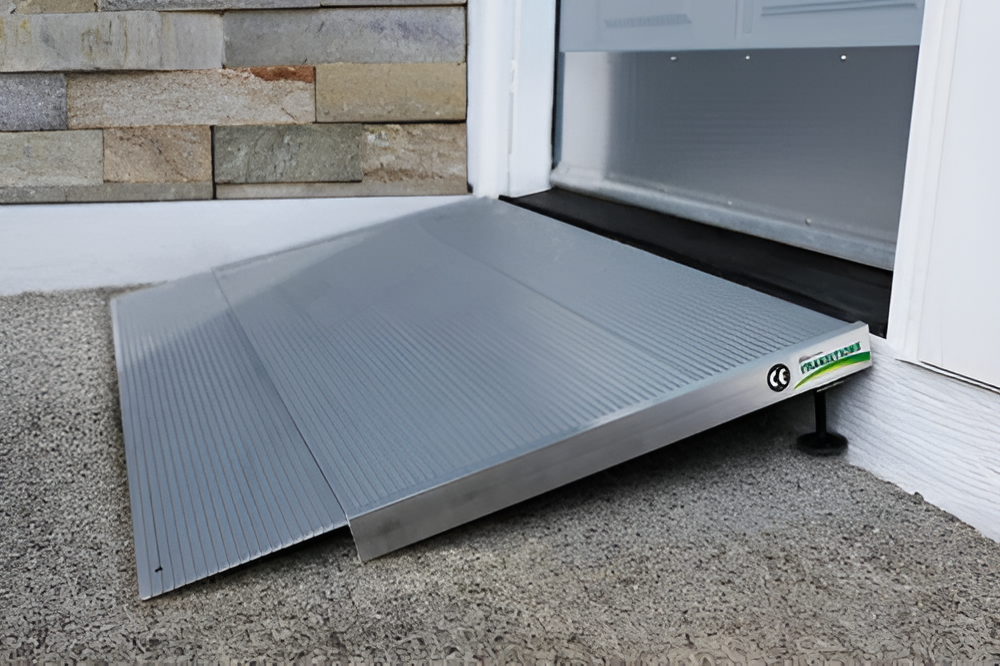Wheelchair ramps are essential for those using mobility devices to safely enter into and exit their homes. Read on to learn more about wheelchair ramps, their history and development throughout history, and what types of wheelchair ramps are currently available.
What are Wheelchair Ramps
Wheelchair ramps are sloped or angled planes that primarily eliminate the barrier that stairs and elevated entrances can present those using either wheelchairs, scooters, or other power-driven or manual mobility devices. Wheelchair ramps allow easy access into homes or buildings and can be used to load devices into the back of a vehicle for transport.
Wheelchair ramps can be either permanently installed, semi-permanently installed, or portable for ease of access on the go.
The History of the Wheelchair Ramps
The history of the wheelchair ramps begins when the ramp was apparently first used by the Egyptians to transport the raw material needed to build the pyramids (2550 to 2490 BC).
Later on, the ramp appears to have been used during the times of the ancient Greeks (700 – 480 BC) in order to move and transport ships. In fact, the Greeks became so adept at building ramps that they constructed a ramp (called the Diolkos) which was used to move ships across what was known as the Corinth Isthmus (a narrow land strip that has oceans on both sides and connects two areas of land).
Then in 525 AD when the wheelchair was first invented in China, a movement ensued to develop a rudimentary wheelchair ramp.
By the 1900s the concept of the ramp was re-developed during the construction of Grand Central Station in New York City which opened in 1913.
The system of ramps in Grand Central Station allowed for the transportation of massive numbers of passengers and porters who were able to move their luggage quickly and safely.
In the late 1940s and 1950s, after the Second World War ended, it became necessary to develop wheelchair ramp technology to accommodate mobility-impaired veterans returning home who required mobility assistance.
By the late 1950s and 1960s with the expansion of the suburbs, there developed a greater demand for wheelchair accessible sidewalks and wheelchair ramps for public buildings.
In 1990 when the Americans with Disabilities Act passed, wheelchair ramps became included by architects when designing new public buildings.
With the passage of the Americans with Disabilities Act in 1990 (https://www.ada.gov/opdmd.htm) wheelchair ramps are now required for all newly constructed public buildings.
Types of Wheelchair Ramps
There are a number of different types of wheelchair ramps that are available. These include:
- Threshold Ramps
Threshold ramps usually range from one-half inch to six inches high and are made of lightweight durable metal, high-density foam, or rubber. They are slip-resistant and can be used on either side of a doorway abutting the door threshold or the curb. They are not permanently attached to the floor and can be moved easily. Threshold ramps are a good option for those using a wheelchair, scooter, or walker temporarily.
- Folding Ramps
Folding ramps are available with either 2 or 4 panels. They have hinges between each panel and do not have handrails. Folding ramps do not meet ADA specifications and should only be used for personal use. They can be used to traverse over a small set of stairs to enter a house.
- Suitcase Ramps
Suitcase ramps fold and have handles and are also not ADA compliant. They range from two to six feet long and can support up to eight hundred pounds of weight. They can easily be put over a small set of stairs.
- Telescoping Ramps
Telescoping ramps have 2 channels which are side by side and are normally less than one foot wide. They expand and contract just like a regular telescope and are excellent for wheel access into a van that is wheelchair accessible.
- Modular Ramps
Modular ramps come in sections that are made off-site and then re-assembled not requiring a construction permit. They can be installed permanently with long-lasting aluminum modular ramps being rust and warping-resistant.
- Permanent Ramps
Permanent ramps require a building permit and are usually made of wood or cement. They are constructed on-site and are ADA compliant.
- Semi-Permanent ramps
Semi-permanent ramps are usually made of durable lightweight aluminum and can be purchased with or without handrails. They are weather-resistant and can be moved if required.
Conclusion
Many people with mobility impairments rely on wheelchair ramps to provide safe access to their homes or vehicles. Wheelchair ramps come in many styles and can be portable, semi-permanent, or permanent. Most wheelchair ramps are made of lightweight, non-corrosive aluminum that can support a weight capacity of 800 to 1000 pounds. They also usually have raised edges to avoid an accidental roll-off.

